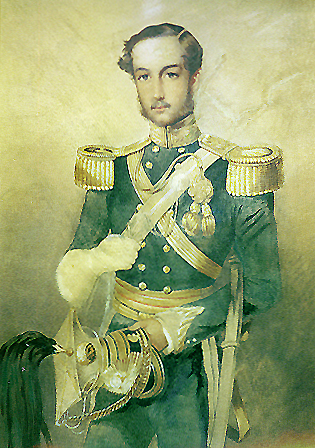
This image and information graciously has been shared with the Victorian Web by Stephen Luscombe and has been taken from his website. Copyright, of course, remains with him. — Marjie Bloy Ph.D., Senior Research Fellow, National University of Singapore.
This portrait of an officer of the 17th clearly shows the full dress uniform worn from 1840 to 1855. Three years after Queen Victoria came to the throne the red jackets imposed on certain regiments of the British Army by William IV were changed back to blue (with the exception of the 16th Lancers who kept theirs). The facings of the 17th were still white, but were not as obvious as in the 1820s when their jackets displayed a white plastron on the front. The collar was covered in gold lace except for a few inches round the back. This collar was three inches high and fasted with hooks and eyes. Underneath it would have been a stiff black stock: all in all a very uncomfortable experience, but designed to make the wearer appear more dignified. All the lace is gold, including the epaulettes which by this time had become quite large. They are very stiff items; the fringes do not move, they are stuck or sewn to a piece of curved leather. The pouch belt is on his left shoulder and it looks like he has another one over his right shoulder but this is a formalised bunching of the caplines which used to be wound around the body according to the whim of the Colonel at the time, but are now following a regulation as laid down by Horse Guards. The caplines ended with flounders and tassles hooked onto the chest; the other end, of course, were fixed to his Czapka [hat] so that it did not get lost when it fell off. He holds the Czapka in his left hand which is obligingly ungloved so that we have a good view of his cuff which is supposed to be white with gold embroidery and is usually covered by a gauntlet. The Czapka has a black patent leather lower half and a white cloth top with gold lace round the 'waist'. The plume is of black feathers. Although this is the full dress uniform worn at the time of the Crimean War, a slightly more comfortable jacket was worn on campaign with a lower and plainer collar. The Czapka was exchanged for a lighter foul-weather version which looked as if it had been made out of a black plastic bin liner.
The following information was received from Jerry Lavender who served in the 17th/21 lancers for 20 years; he is a keen Napoleonic "buff" and a reenactor of the Polish Guard Lancers.
The first British cavalry regiment to convert to lances was the 16th Light Dragoons and the instructors were Non-Commissioned Officers and Officers from the Polish Guard Lancers. In 1816 the drill manual was the same as the French/Polish manual of 1810/1812. The current 1902 manual is a British copy of the original with some small changes. The Queen's Own Lancers still use the current regiment this manual.
The first lances issued were taken from the field at Waterloo in June 1815 and were issued to the regiment. The only chapska known of a 1816 British officer is held in a private collection in Lewes, Sussex, England and is that of a 16th Dragoon (lancers) and a direct copy of the latter's pattern issued to the Guard Lancers.
Last modified 23 May 2002